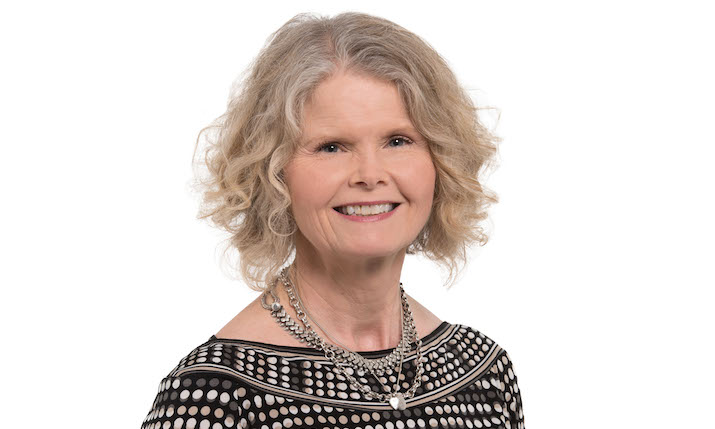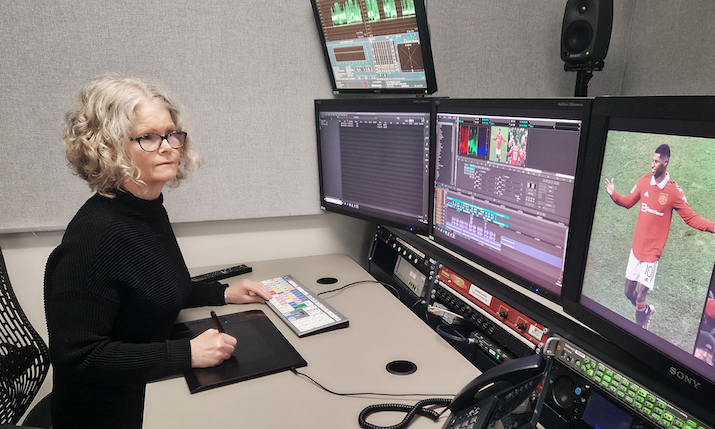Making the cut: Sky editor Irene Kelly’s journey from DigiBeta to remote production

Kelly: ‘Choose a company which has a clear mission statement about diversity, equality and fairness’ Picture: Ali Painter/Sky
“I’ve been working as an editor at Sky for over 30 years now and my job has never become boring,” says Sky Post Production’s Irene Kelly. “Continual changes in technology, the introduction of fast turnaround motion graphics on sports pieces from 2000 onwards, the excitement of a live sports environment, and the endless creativity of colleagues results in a job that remains enjoyable, challenging and hugely satisfying.”
But Kelly had a roundabout journey into TV broadcasting. “When I started my career in the 1980s, roles in TV were far less plentiful than now. My goal when I moved from Ireland to London, was to work as a sound engineer in recording studios,” she says. “I considered studying electronics at college but left secondary education and went straight into work in a recording studio – at that time most entry-level jobs in recording studios were for teaboy/girl. You trained on the job and worked your way up. I would love to have had the opportunity to do a media course in higher education, but I am grateful to have had opportunities at Sky over the years to take part in training courses that have developed my skills on the job.”
During a working holiday in Australia, Kelly took a job as a runner for an offline editing company. “I fell in love with video editing and that became my new goal.”
Back in London, she was deemed too old at the age of 26 to be a runner but due to her sound engineering experience, she was taken on by TVi Wardour Street in 1988 as a junior dubbing mixer.
At that time Sky Television transmitted a single entertainment channel from TVi and used its post facilities for on-air promotions.
“In 1989 there was an exodus of operational staff from TVi to the newly launched multi-channel Sky TV in Osterley, and I was one of those who made the move,” recalls Kelly. “In the beginning, sports content on Sky was a single channel – Eurosport. As a dubbing mixer, my main role was working with Eurosport producers, voicing highlights packages of a multitude of sports from across Europe. Working with multi-language feeds – German, Dutch and English – recorded on DigiBeta tape and performing live audio drop-ins was an interesting challenge!”
Sky Sports launched in 1991 and gained rights to the English Premier League in 1992. “During this time there were changes across most departments at Sky,” says Kelly. “Many of us with clear goals could use the momentum to move forward. I was given a role as a junior video editor with a roster of work focused on sports – highlight packages, features and promos.”
Evolution and promotion
“Sky is constantly evolving and moving forward. During the most recent of our transformations, I applied for a senior video editor role specialising in sports motion graphics,” says Kelly. “I started using Adobe After Effects (AE) in 2005 and have loved working with motion graphics ever since. I was inspired by a colleague at Sky who pioneered the use of AE for our sports openers. Motion graphics are used to great effect on high-profile sports – football, F1 and cricket – but the use of motion graphics to elevate short-form pieces for sports such as darts was revolutionary. It’s played a huge part in raising the profile of that sport and introducing it to a new demographic and audiences across the globe.”

Kelly: ‘I have always felt inadequate about my lack of technical education, but I don’t believe that has largely impacted on my career path’
“One of the most difficult aspects of working with motion graphics is that once a concept and style have been agreed upon with a sports producer, the editor will generally work alone,” she continues. “When working [like this] you can only blame yourself if a plan does not reach a happy conclusion. Motion graphics work needs expert technical knowledge of your chosen software as well as understanding and respect for graphic design. Most video editors do not come from a design background, so we need to acquire design knowledge and stay up to date with trends. Technically there are far more surprises working with graphics than working with pre-recorded sound and vision. At Sky, we have a supportive group of motion graphics editors – having colleagues to lean on in times of need is a vital lifeline as After Effects is a huge, versatile piece of software and my colleagues all have their approaches to it.”
Then there are challenges around deadlines and efficiency. “The expectation of what can be achieved in an edit day (which has reduced from 12 hours to 9 hours over the years) is huge,” says Kelly. “Yes, we have better tech and a lot more pre-prepared assets to use now but even so, an editor needs to hit the ground running at the start of edit day to ensure that a creative piece is delivered on time for approval with graphics, grade, audio mix and added sound effects. As with all our work, the content needs to be editorially, technically and aesthetically correct.”
Sports video editors at Sky work closely with production teams to create high-impact short-form pieces. “Many of the production team have developed good editing skills so that prep delivered to the edit suite needs less editing time,” Kelly explains. “A huge part of sports work now is focused on the online and finishing skills of an editor. Finessing offline edits, creating motion graphics and transitions, grading shots, and building an impactful sound mix is all important these days.”
When the Sky Sports Racing channel was announced in 2018, Kelly was excited to be offered a lead editor role working with the SSR production team, who were all new to Sky.
“My role was really interesting as it gave me a great insight into how a new sports brand evolves,” she explains. “My team edited hours of new HD content for the launch, in-house creatives designed a cool, modern look for the channel, and our tech team moved mountains to get the innovative studio [which has four robotic cameras, including two on rails] ready for launch on 1 January 2019. It was a mammoth task, and I was proud to be part of the team.”
“A huge part of sports work now is focused on the online and finishing skills of an editor. Finessing offline edits, creating motion graphics and transitions, grading shots, and building an impactful sound mix is all important these days”
As part of the edit team delivering Women’s Super League (WSL) content for Sky Sports, Kelly is looking forward to new challenges. “The success of Sky’s coverage means the team can look to innovate and continue to deliver ever higher quality work for a growing audience,” she adds. “I love tennis, so the return of the US Open to Sky is very exciting and I’ve got my hand high in the air to work with that team!”
“Although we all started working from home in 2020 during the pandemic, I believe this past year Sky has finessed remote working for sports productions, making it a completely viable choice,” she observes. “This past year our tech teams and sports editors have evolved working practices and improved virtual machine technology, allowing sports edit teams to be equally creative whether working from our homes or onsite at Sky.
“I have also had the opportunity to work as part of an OB edit team, not in a truck at the venue, but in an edit suite at Sky,” she continues. “This was a real step forward in my opinion – I did not have the opportunity to work on OBs earlier in my career when my son was young. Already working anti-social hours in London, onsite OB work would have added to time away from home. I believe the option of remoting into the OB from Sky would have allowed me to be included in some of those events I missed out on, and I am glad that this technology will have a positive impact on other women in sport, and the work/ life balance.”
Dedication and determination
Her advice to other women looking to move into a role in sports broadcasting is to just get your foot in the door. “Whatever your starting point, a good company will offer opportunities to all their people and those with talent, determination and energy will always do well,” she adds. “When you know what you would like to do, research all the companies with opportunities in that role. Choose a company which has a clear mission statement about diversity, equality and fairness.”
“I would say most of my challenges come from the stereotypes available to me during my formative years,” she continues. “I have always felt inadequate about my lack of technical education, but I don’t believe that has largely impacted on my career path. Spending extra time in the edit suite upskilling to ensure I’m ready for challenges can sometimes impact my work/life balance, but I’m happy to put in the effort as it gives me the confidence to push out of my comfort zone.”
